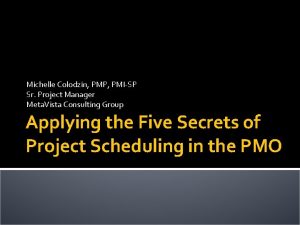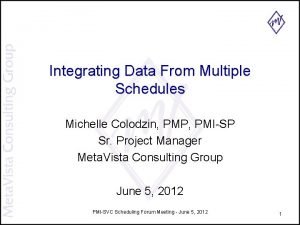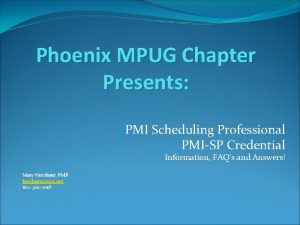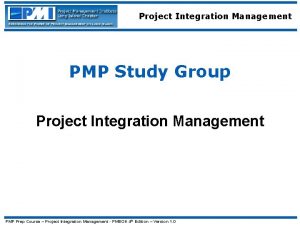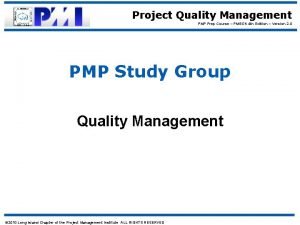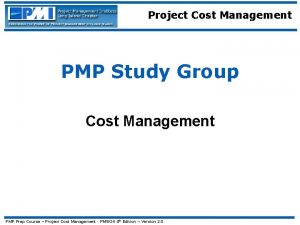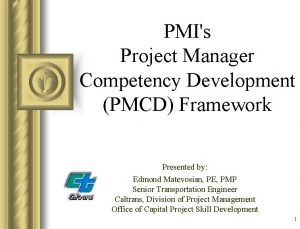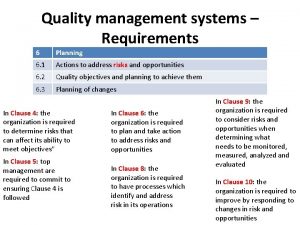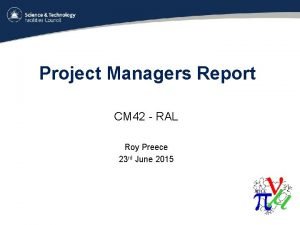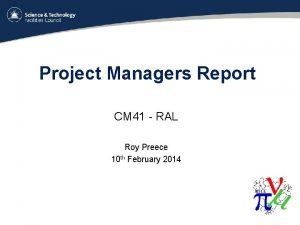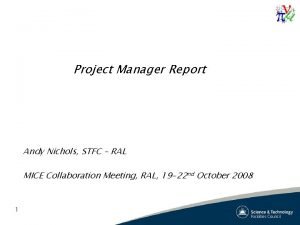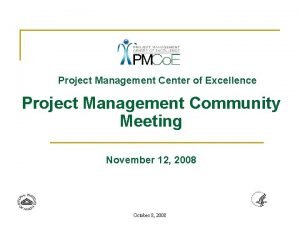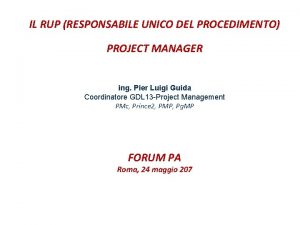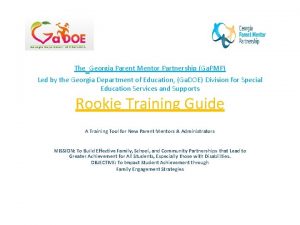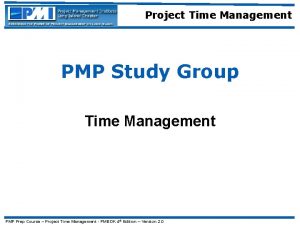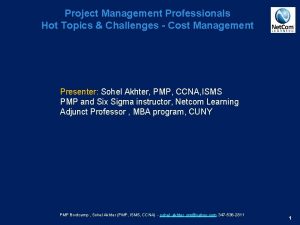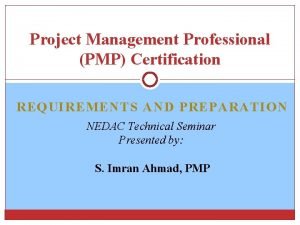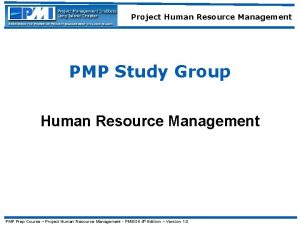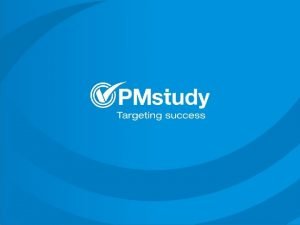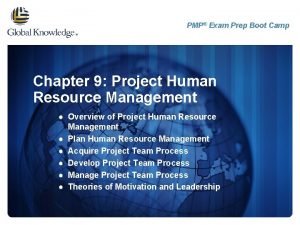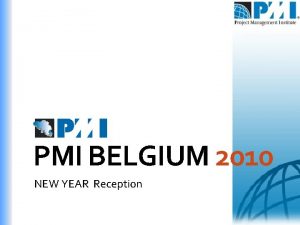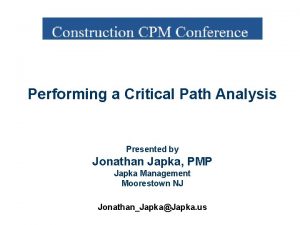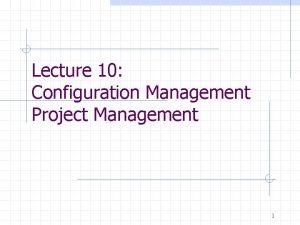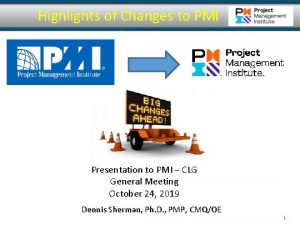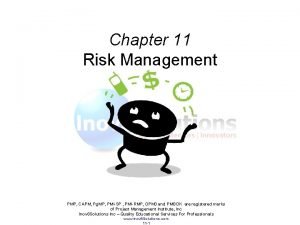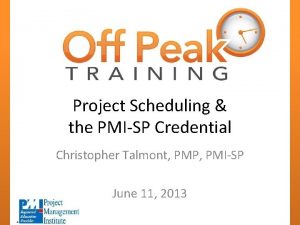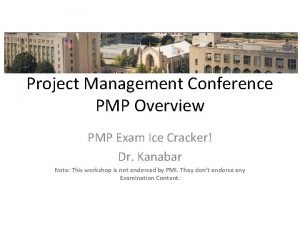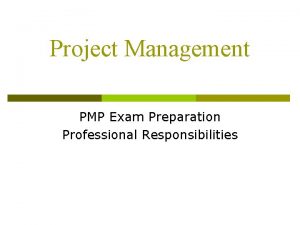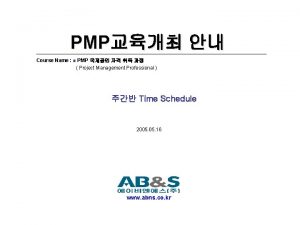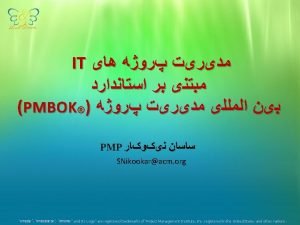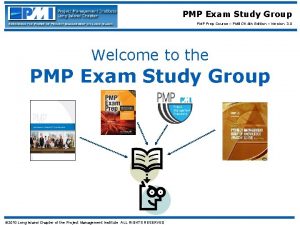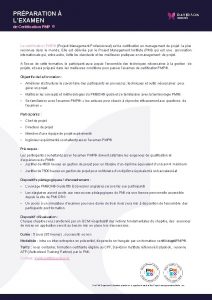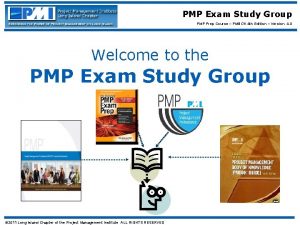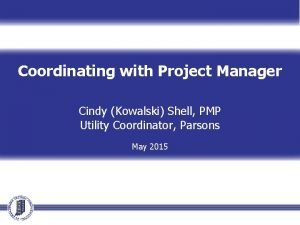Michelle Colodzin PMP PMISP Sr Project Manager Meta









































- Slides: 41

Michelle Colodzin, PMP, PMI-SP Sr. Project Manager Meta. Vista Consulting Group Applying the Five Secrets of Project Scheduling in the PMO

A Couple of Notes Unless otherwise noted, the roles of Project Manager (PM) and Project Scheduler are used interchangeably PMs are assumed to create and maintain their own project schedules It is not necessary to have detailed knowledge of the Five Secrets of Project Scheduling to understand or benefit from the information presented here This presentation provides a high-level overview of the ‘Five Secrets’ but does not go into detail ‘The Five Secrets of Project Scheduling’ is available from the presenter or on the PMI Virtual Library for those who want more information

Agenda Overview of The Five Secrets of Project Scheduling Understanding the Scheduling Center of Expertise Defining the Scheduling Center of Expertise Benefits of a Scheduling Center of Expertise Building a Scheduling Center of Expertise Gaining Buy-in and Support Identifying the Strengths and Maturity Level of the PMO Creating a Plan Establishing the Scheduling Center of Expertise Growing the Scheduling Center of Expertise

Introduction

What are The ‘Five Secrets’ of Project Scheduling? The ‘Five Secrets’ are five factors that help project managers build good project schedules that are easy to maintain They need to be applied consistently to provide the best benefits It can be difficult to take full advantage of all of the ‘secrets’ without the structure and support of a centralized organization This centralized organization is called a “Scheduling Center of Expertise” (SCo. E)

Overview of The Five Secrets of Project Scheduling #1: Create deliverables-based project schedules #2: Determine and apply the appropriate level of detail #3: Implement a regular status update and reporting process #4: Review and adjust the schedule regularly #5: Create and follow scheduling standards

The Five Secrets – Why Should I Care? Most PMs are aware that a good project schedule improves the chance of project success, but: Many PMs feel it takes too much time to build and maintain a good schedule Most schedules are built as quickly as possible and then either poorly maintained or abandoned This reinforces the notion that good scheduling practices take time away from managing the project

The Five Secrets – Why Should I Care? A good schedule provides critical information that can help PMs focus their time and efforts resulting in: Increased efficiency Identification and avoidance or mitigation of potential problems before they occur A well built project schedule minimizes the time required to maintain it when following good schedule management practices

Secret #5 and the PMO Create and follow scheduling standards A proven approach to minimizing the time to build and maintain a project schedule is to: Use schedule templates created from similar projects Apply the same standards to all schedules Learn from the successes and pitfalls of other projects and project managers (apply lessons learned) Follow processes that have worked well in the past Leverage pre-configured scheduling tools and templates that are aligned with scheduling standards This approach is most effective when applied through a centralized scheduling function within the PMO – A Scheduling Center of Expertise

Defining The Scheduling Center of Expertise

Defining the Scheduling Center of Expertise A Scheduling Center of Expertise (SCo. E) is defined as a group or organization focused on developing and championing the consistent use of proven project scheduling practices throughout its scope of control or influence.

The Components of a Scheduling Center of Expertise To be most effective, a SCo. E must have the following components: Staff with the knowledge, skills and abilities (KSAs) to: Build and manage good project schedules Define scheduling standards Evaluate, select and implement scheduling tools Create templates and tools aligned with the selected scheduling standards Identify and collect metrics to track compliance and project success rates over time

The Components of a Scheduling Center of Expertise To be most effective, a SCo. E must have the following components: A process for continuous improvement A lessons learned repository A process for documenting and categorizing project histories and key statistics Sufficient authority or influence to enforce processes and practices An outreach and training program for PMs Executive management willing to actively support and �promote the SCo. E

The Benefits of a Scheduling Center of Expertise

Organizational Benefits of a Scheduling Center of Expertise Organizational benefits from increased project success rates include: Increased profitability Decreased costs A more efficient operation and workforce Ability to take on more simultaneous projects Ability to take on more complex projects Faster response to legislative or regulatory changes Faster time to market for new products

Human Resource Benefits of a Scheduling Center of Expertise More productive and highly skilled PMs A clear career path for PMs Better job satisfaction and morale Reduced attrition rates among PMs

Building a Scheduling Center of Expertise

Steps to Building a Scheduling Center of Expertise Gain executive buy-in and support Identify the strengths and maturity level of the PMO Create a Plan Establish the SCo. E Grow the SCo. E

Gaining Executive Buy-in

Gaining Executive Buy-in and Support Step 1: Understand how the PMO is aligned with the organization’s goals and objectives Step 2: Determine how a SCo. E can contribute to these goals and objectives

Step 1: Understand how the PMO is aligned Understand exactly what is expected of the PMO: Scope Budget How do executives measure the PMO’s performance (including metrics, if applicable) Understand the evolution of the PMO Original business drivers that led to its creation How has its charter and scope changed over time Major successes and failures

Step 2: Determine How the SCo. E Can Contribute Determine how the SCo. E will contribute to: The success of the PMO The success of the organization as a whole The success of the decision-maker(s) within the organization Remember that decisions are made by people Most people want to know “what’s in it for me” before taking a risk

Identify the Strengths and Maturity Level of the PMO

Identify the Strengths and Maturity Level of the PMO All organizations have strengths and areas where they can improve A key to success is understanding how to build on the strengths and where the SCo. E can help improve the PMO and organization Strengths Improvement Opportunities Dedicated staff willing to learn Inexperienced project managers and high turn-over rates A culture open to new ideas and taking risks 75% of projects are over budget by more than 15% Ability to learn from mistakes 80% of projects finish late by more than 25%

Identify the Strengths and Maturity Level of the PMO Characteristics of a mature PMO include: Clear, well defined processes that are followed and enforced Templates and tools that are used regularly by PMs The ability to gather and track metrics A lessons learned and project history repository More mature organizations may be able to take on several goals and objectives early on Less mature organizations will need to start small and build on successes

Create a Plan

Define the Goals and Objectives Build on the strengths of the PMO Define the goals and objectives of the SCo. E Review the benefits, strengths and improvement opportunities Identify a small number of improvement opportunities that leverage strengths and provide the biggest benefits Strengths Improvement Opportunities Dedicated Inexperienced staff willing to project managers learn and high turn-over rates Goals and Objectives Benefits Increase experience • More productive PMs and skill level of • Able to take on more complex PMs projects • Better job satisfaction and morale Reduce PM • Reduced attrition rates turnover • Increased project success rates

Determine How Success Will be Measured Identify meaningful quantifiable measures that can be easily tracked on an ongoing basis Success criteria may change or expand over time as initial goals and objectives are met Goals and Objectives Increase experience and skill level of PMs Benefits • More productive PMs • Able to take on more complex projects • Better job satisfaction and morale • Reduced attrition rates • Increased project success rates Metric Success Criteria Number of PMs w/ PMP certification 25% of all PMs in first year Reduce PM attrition 15% lower attrition rate w/in 18 months

Identify Required Changes Review the organizational structure of the PMO and its place in the overall organization How well will it support the SCo. E’s goals and objectives? Does it have sufficient authority or influence? What changes might be needed? Review the list of KSAs to determine which exist in the PMO today How will staff acquire the KSAs required to make the SCo. E successful? Will talent need to be brought in from outside?

Pitch Your Idea You’ve done your homework – now you’re ready to pitch your idea!!! Estimate funding requirements Be prepared to answer questions Anticipate resistance and prepare responses in advance

Establish the Scheduling Center of Expertise

Start Small Review your goals and objectives Identify those you’ll focus on first Start small and focus on the strengths of the organization Remember that this is a starting point – not the ultimate goal Review your metrics – update or add as needed Establish a baseline for each metric – for example: How many PMs currently have their PMP certification? What is the current PM attrition rate?

Refine Your Success Criteria Current State (baseline): 100 PMs Five PMs (or 5%) have their PMP The turnover rate is 20% per year The date is January 1 st 2010 Document specific success criteria including timeframe Goals and Objectives Metric Success Criteria Current State Goal State Increase experience and skill level of PMs Number of PMs w/ PMP certification 25% of all PMs in first year 5 PMs have their PMP 25 PMs have their PMP by 12/31/10 Reduce PM attrition Annual PM attrition rate 15% lower attrition rate w/in 18 months Turnover rate is 20% Turnover rate is 17% by 6/30/11

Establish Standards Establish scheduling standards such as: A basic WBS template ▪ WBS Level 1: all deliverables listed in the project charter ▪ WBS Level 2: key milestones associated with completing each deliverable ▪ WBS Level 3: tasks and activities required to reach milestone The level of detail each schedule is to contain (work package size range, how to handle administrative tasks and time, etc. ) All detail tasks must have at least one predecessor (except the 1 st) and at least one successor (except the last) Report templates Common metrics to be tracked by all project managers A basic schedule change control process

Build Tools for Success Examples of tools: A Schedule Management Plan template that is aligned with the scheduling standards A lessons-learned repository A project history and project artifact repository with sample work products and process flows that have worked well in the past A PMP training program (could be in-house or commercial) The key is to make it easier for project managers to ‘do the right thing’ which can: Reduce the administrative overhead associated with starting a new project Reduce the time required to develop and maintain the project schedule Improve project success rates Improve PM morale – we all like to succeed!

Grow the Scheduling Center of Expertise

Build on Early Successes Establish a process for continuous improvement Track progress against the baseline and make sure key stakeholders are aware of successes When executives see the value they’ll be more likely to approve and fund growth plans Define the next set of goals and objectives These may be stretch goals or a logical progression from the initial goals and objectives

Expand the Scope of Control Establish a Project Scheduler position (if it doesn’t already exist) Lower level position that starts at the CAPM level and goes up from there Could be an entry-level position for individuals interested in getting into project management Could provide a career path for those who don’t want to become PMs but have an interest in project management concepts and applications Have PMs and Schedulers report directly into the SCo. E This can be politically sensitive – be prepared to show the benefits to the organization as well as to managers who may be losing people to the SCo. E Provide PMs and Schedulers to other groups in the organization that are initiating projects Provides better control over implementation of processes and consistent use of tools and techniques Organizations are more likely to accept this after they’ve seen early successes

Conculsion

Some Final Thoughts A Scheduling Center of Expertise can improve project success rates through: Standardization Consolidation of skills and experience Retention of talented PMs and schedulers Start small and build on successes Define clear and measurable goals and objectives Define success criteria up front Establish a baseline to measure against Grow the Scheduling Center of Expertise Develop a plan for growth based on previous successes Expand the Scope of Control ▪ Have project managers and schedulers report directly to the Scheduling Center of Expertise ▪ Assign PMs and Schedulers to projects throughout the organization

Contact Information: Michelle Colodzin, PMP, PMI-SP Meta. Vista Consulting Group 2411 15 th St. , Suite A Sacramento, CA 95818 mcolodzin@metavista. com 530 -798 -1656
 Michelle colodzin
Michelle colodzin Michelle colodzin
Michelle colodzin Pmisp
Pmisp Meta synthesis vs meta analysis
Meta synthesis vs meta analysis Process indicators enable a software project manager to
Process indicators enable a software project manager to Integration project plan
Integration project plan Perform quality control
Perform quality control Pmp quality management
Pmp quality management Project cost management pmp
Project cost management pmp Senior manager vs general manager
Senior manager vs general manager Portfolio manager synergy manager parental developer
Portfolio manager synergy manager parental developer Project management competency framework
Project management competency framework Liquor supplier quality project manager
Liquor supplier quality project manager Multimedia project management
Multimedia project management Ral project manager
Ral project manager Ral project manager
Ral project manager Project manager ral
Project manager ral Customer excellence project manager
Customer excellence project manager Certificato iso 21500
Certificato iso 21500 Ga pmp
Ga pmp Pmp y mrp
Pmp y mrp Project time management definition
Project time management definition Residual risk and secondary risk pmp
Residual risk and secondary risk pmp Bac pmp
Bac pmp Project management planning
Project management planning Framework pmp
Framework pmp Rodney grubb
Rodney grubb Project management human resources
Project management human resources Pmstudy pmp
Pmstudy pmp Global knowledge pmp boot camp
Global knowledge pmp boot camp Pmp certification belgium
Pmp certification belgium New mexico board of pharmacy license verification
New mexico board of pharmacy license verification S curve pmp
S curve pmp Pengertian penjaminan mutu pendidikan
Pengertian penjaminan mutu pendidikan Narx score texas
Narx score texas Configuration management project management
Configuration management project management Pmp tasks
Pmp tasks Edward schlosser
Edward schlosser Pmp resource histogram
Pmp resource histogram Pmp secondary risk
Pmp secondary risk Pmp vs lmp obstetrics
Pmp vs lmp obstetrics Pmp 42a
Pmp 42a
